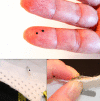Experimental Measurement of the Size of Gaps Required to Compromise Fit of an N95 Respirator
- PMID: 35057880
- PMCID: PMC8961060
- DOI: 10.1017/dmp.2022.23
Experimental Measurement of the Size of Gaps Required to Compromise Fit of an N95 Respirator
Abstract
Objective: The effectiveness of filtering facepiece respirators such as N95 respirators is heavily dependent on the fit. However, there have been limited efforts to discover the size of the gaps in the seal required to compromise filtering facepiece respirator performance, with prior studies estimating this size based on in vitro models. In this study, we measure the size of leak necessary to compromise the fit of N95 respirators.
Methods: Two methods were used to create a gap of specific dimensions. A set of 3D-printed resin spacers and hollow steel rods were used to generate gaps in N95 respirators while worn on 2 participants. Occupational Safety and Health Administration (OSHA) quantitative fit testing methods were used to quantify mask performance with gaps between 0.4 and 2.9-mm diameters.
Results: Gap size was regressed against fit factor, showing that overall, the minimum gap size to compromise N95 performance was between 1.5 mm2 and 3 mm2.
Conclusions: These findings suggest the fit of a N95 respirator is compromised by gaps that may be difficult to visually detect. The study also adds to the body of evidence supporting the routine use of quantitative fit testing to ensure that masks are well-fitting.
Keywords: COVID-19; SARS-CoV-2; coronavirus; face coverings; quantitative testing.
Figures


References
-
- Crutchfield CD, Park DL. Effect of leak location on measured respirator fit. Am Ind Hyg Assoc J. 1997;58(6):413-418. - PubMed
-
- McKay RT, Davies E. Capability of respirator wearers to detect aerosolized qualitative fit test agents (sweetener and Bitrex) with known fixed leaks. Appl Occup Environ Hyg. 2000;15(6):479-484. - PubMed
MeSH terms
LinkOut - more resources
Full Text Sources
Medical
Miscellaneous

